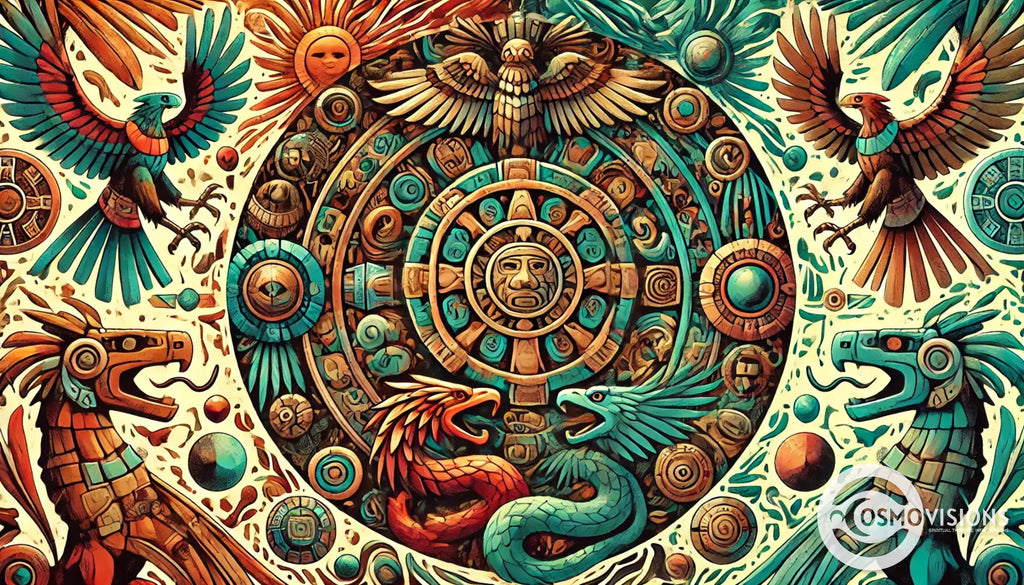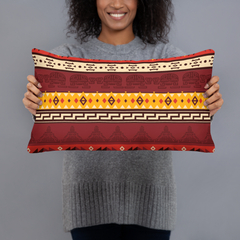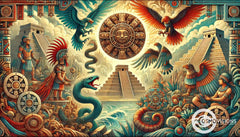Exploring the Aztec Calendar: The Symbolism of the Sun Stone
Posted by Massimiliano Geraci

Have you ever looked at the Aztec calendar or Sun Stone and wondered what all those symbols mean? You’re not alone. Many people find the ancient system fascinating but complex to understand.
The Aztec calendar is more than just a way to mark time. It’s a window into how the Aztecs viewed the world, their gods, and their place in the cosmos.
The Aztec calendar reflects the broader cultural and religious practices of the Aztec civilization. It combines two cycles: a 365-day cycle related to agriculture and a 260-day ritual cycle for ceremonies. These cycles create a 52-year period known as the “calendar round.” This blog post will help you understand these cycles, what the Sun Stone represents, and how they played a crucial role in guiding daily life for millions of people in ancient Mexico.
Let’s uncover these mysteries together—read on!
Key Takeaways
The Aztec calendar blends two cycles, a 260-day ritual cycle and a 365-day agricultural cycle, forming a unique 52-year period called the "calendar round." This system shows their deep connection to nature and gods.
The Sun Stone is not just art; it's an ancient timekeeper unveiled in Mexico City in 1790. Weighing as much as three elephants and displaying the sun god Tonatiuh at its center, it details the Aztecs' time periods and cosmic beliefs.
The Aztec calendar provided daily guidance based on divine influences through trecenas and day signs, each linked to guardian deities or spiritual forces from four main directions.
Differences between Aztec and Mayan calendars highlight distinct cultural perspectives on timekeeping despite shared roots. While both have similar cycles, their names for days, gods involved, and inclusion of epochs like the Long Count set them apart.
Modern scholars and artists are reviving interest in the Aztec solar calendar by interpreting its symbols anew. Their work helps preserve ancient practices that deeply integrated natural cycles with human life.
Modern scholars and artists are reviving interest in the Aztec solar calendar by interpreting its symbols anew. Their work helps preserve ancient practices that deeply integrated natural cycles with human life.
Overview of the Aztec Calendar System
The Aztec calendar showcases a complex blend of precision and spirituality, deeply rooted in the Mesoamerican traditions of timekeeping. The Aztec calendars, including the 365-day xiuhpōhualli and the 260-day tōnalpōhualli, were central to their culture. The xiuhpōhualli guided agricultural endeavors under the sun’s watchful eye, while the tōnalpōhualli marked time with sacred rituals. These calendars structured daily life and held significant religious and cultural importance.
These cycles intertwine to form what many call a 52-year “calendar round,” reflecting both the rhythm of nature and divine influences. Guided by detailed observations of celestial movements, these calendars embody the Aztecs’ profound connection to their environment and their gods.
Key to understanding this intricate calendrical machinery are terms such as tonalpohualli (day count) for tracking ritual days and xiuhpōhualli (year count) for managing farming seasons—each cycle resonating with its purpose yet harmoniously linked within a broader temporal framework.
This duality captures the physical aspects of time and its spiritual dimensions, unfolding across centuries in an ongoing dialogue between earthbound beings and cosmic forces.
Through meticulous adherence to these systems, every planting season found its auspicious start; every community ceremony aligned with celestial wisdom—the very essence of life woven through time’s fabric.
Moving forward, let us delve into The Tonalpohualli: Sacred 260-Day Cycle to uncover how these ancient practices continue to unfold meanings centuries later.
The Tonalpohualli: Sacred 260-Day Cycle
The Tonalpohualli, or the sacred calendar, is a complex and important 260-day ritual cycle. It marks each day using numbers from one through thirteen combined with twenty special symbols, creating a unique pattern.
Groups of these days form thirteen-day periods called trecenas. Each trecena has its own guardian spirit. Every day holds a universe of possibilities. This calendar organizes time into a rhythm that connects daily life with cosmic movements. Every period and symbol carries meaning, linking people with higher forces. For those who follow this ancient system, it offers guidance and insight into personal growth and community harmony.
Aztec
The Xiuhpohualli plays a key role in tracking the seasons. It guides farmers on when to plant and harvest crops. This calendar has 360 named days plus 5 extra, nameless days known as nēmontēmi.
Aztec priests conducted religious services, tracked celestial events, and made important decisions based on the calendar.
These are times of reflection and rest for the people. The year divides into 18 periods, each lasting twenty days.
Aztecs used signs and numbers to mark years in a special cycle of 52 years called Xiuhmolpilli or Xiuhnelpilli. Every end of this cycle was significant, marking a full circle of time passed.
They celebrated with ceremonies believing this cycle tied closely to the forces of nature and life itself.
The Aztec Calendar Stone: Symbolism and Significance
Moving from the agricultural calendar, we explore the Aztec Calendar Stone‘s deep symbols and their meaning. Workers found this huge stone in Mexico City in 1790. It’s big—12 feet across and weighs as much as three elephants! At its center, it shows Tonatiuh, the sun god’s face.
This artwork also marks four big time periods before ours.
The Aztec Calendar Stone is a significant artifact from the Aztec Empire, which thrived under the reign of Moctezuma II. This stone is not just art; it tells time and stories of gods and worlds past. According to Aztec beliefs, each circle and figure on it has a story about time cycles, life energy, and the universe. The calendar played a crucial role in Aztec ceremonies and religious rituals, reflecting the cultural and religious significance of the Aztec calendar.
It reminds us how advanced the Mexica people were in understanding time and space long ago. They saw their world in layers of myths tied to real celestial movements, making this stone a bridge between earth, sky, and everything beyond.
Aztec
Supplementary Insights on the Aztec Calendar and Sun Stone Peeling back the layers of the Aztec calendar and Sun Stone reveals stories of gods and time. This journey uncovers how people long ago marked days, celebrated, and honored their deities.
Aztecs believed in periodic apocalyptic catastrophes, the annihilation and rebirth of humanity, and the requirement of human sacrifices to prevent world destruction at the end of a 52-year calendar round. Their beliefs were deeply intertwined with the passing of time and the recurring cycles of destruction and rebirth.
The practice of human sacrifice was crucial in Aztec religious beliefs and ceremonies, particularly in appeasing the sun god Tonatiuh and ensuring the sun's renewal through the New Fire Ceremony.
Key Deities Associated with the Calendar
The Aztec calendar brims with power and mystery, thanks to the gods that infuse it with life. Each of the trecenas, or 13-day periods, has its own guardian deity watching over it.
This setup makes every day unique, carrying the energy these divine figures give. Tonatiuh, the fierce sun god, rules over all as we live in what the Aztecs called the Fifth Sun.
His strength and fire light up our days and guide us through time.
Every day sign in this ancient system links to one of four main directions—north, south, east, or west. These connections aren't random; they're tied deeply to how the Aztecs saw the universe's structure.
They believed each direction had its special force and god, who influenced life on Earth through numbers and signs in their sacred calendars. The combination of a number from 1 to 13 with a day sign dictated how this celestial energy played out in daily life.
Each step we take is watched over by eyes more ancient than our own.
Aztec
Differences Between Aztec and Mayan Calendars
Aztec and Mayan calendars share roots but walk different paths. Aztecs built on the Mayan system. Both crafted a 260-day ritual cycle and a 365-day civil one. Yet, their day names and gods diverged.
Aztecs called theirs tonalpohualli; Maya named it Tzolk'in.
Maya included the Long Count in their scheme, mapping epochs not seen in Aztec timekeeping. This distinction underlines unique cultural imprints upon each civilization's view of cycles within the cosmos.
Through these lenses, they interpreted their world and its divine orchestration differently, showcasing a rich tapestry of Mesoamerican chronometry that continues to fascinate today.
Modern Interpretations and Uses of the Aztec Calendar
Today, artists and scholars explore the Aztec calendar with fresh eyes. Rafael Tena, Ruben Ochoa, and José Genaro Emiliano Medina Ramos lead this journey. They bring back ancient knowledge through new versions of the calendar.
Their work shines a light on its cultural depth.
The Aztec solar calendar lives in museums and art around the world. Its images spark curiosity in those who see it. This ancient timekeeper connects us to a civilization that valued cycles of life and nature deeply.
Through study and reinterpretation, we keep the spirit of the Aztecs alive today.
Conclusion
The Aztec Calendar and Sun Stone open doors to understanding vast ancient wisdom. These tools show us how the Aztecs marked time, honored gods, and viewed their place in the cosmos.
The Calendar weaves together days and years into a deep narrative of life cycles; the Sun Stone captures a universe on stone, guiding us through past worlds. We keep learning from history through these artifacts—bringing ancient stories into today's world.
1. What is the Aztec Sun Stone?
The Aztec Sun Stone is a large, circular sculpture that shows the sun god, Tonatiuh. People see it at the National Museum of Anthropology in Mexico. It tells about time and Aztec beliefs.
2. How did the Aztecs use their calendar?
The Aztecs used two main calendars. One was 260 days long for rituals, and another was 365 days long, like our year today. They kept track of important times to do things and celebrate.
3. What does "Tonalli" mean in the Aztec world?
In the world of the Aztecs, "Tonalli" meant a day or someone's fate decided by stars and gods. It was very special to them.
4. Can you tell me about a special ceremony they had every 52 years?
Yes! Every 52 years, the Aztecs held a New Fire Ceremony. They thought lighting new fires everywhere would keep their world safe for another cycle.
5. Who found out what the Sun Stone means?
A smart person named Antonio de León y Gama studied it long ago when people found it again in Mexico City's center square called Zócalo.
6. Why are there pictures of two animals on this stone?
These animals - one is Tochtli (rabbit), and another might be Cuetzpallin (lizard) - show parts of their calendar system and beliefs about life cycles.






















